Popularization of Carbon Capture and Storage Technology in Society: Principles and Methods
Abstract
1. Introduction
- −
- Analysis of the literature dedicated to modern approaches to the popularization of new technologies in society;
- −
- Identification of the factors affecting the choice of tools for the popularization of CCS technology in society and the effectiveness of their application;
- −
- Development of the principles of CCS technology popularization;
- −
- Identification of advantages and disadvantages of various methods of popularization of carbon dioxide capture and storage technology.
2. Materials and Methods
- −
- −
- −
- Available reviewed papers. The analysis was conducted based on a few keywords, such as “CCS project”, “carbon capture and storage”, “social license to operate”, “CCS project perception”, and “CCS project attitude”.
3. Theoretical Framework
- −
- Availability of permanent sources of CO2 emissions;
- −
- Availability of underground storage located close to sources (for example, deposits at a late stage of development and deep-lying aquifers);
- −
- Availability of prospects for creating infrastructure for the implementation of the project.
- Technical barriers.
- 2.
- Legal and regulatory barriers.
- 3.
- Economic barriers.
- 4.
- Public perception barriers (public awareness and acceptance).
- −
- −
- −
4. Results
4.1. An Approach to the Popularization of Carbon Dioxide Capture and Storage Technology
- Personal characteristics of the target group, such as age, social status, income level, and gender.
- 2.
- General level of education and level of awareness of global environmental problems, including greenhouse gas emissions.
- 3.
- Level of environmental responsibility and concern about environmental problems.
- 4.
- Personal positive or negative experiences associated with the implementation of CCS or mining projects.
- 5.
- Regional aspect: the degree of proximity of the target audience to the area of potential or actual CCS project implementation.
- 6.
- Degree of trust in persons implementing measures aimed at CCS technology popularization.
- 7.
- Degree of trust in authorities at the federal, state, and local levels.
- Timeliness. Engagement with a wide range of stakeholders should begin before the launch of a CCS project. This allows active involvement of interested groups in discussions of significant aspects of the application of carbon dioxide capture and storage technology, in addition to demonstrating that the opinion of civil society has value.
- Accessibility of information. The global nature of CCS technology implementation determines the need for free access of a wide range of stakeholders to information.
- Clarity. It is necessary to make information understandable to stakeholders, taking into account the characteristics of the target group.
- Balance. The implemented methods of carbon dioxide capture and storage technology popularization should disclose both positive and negative aspects of its application.
- Monitoring and response. Monitoring allows changes in the public perception of CCS technology to be tracked. This also provides information for making a decision about whether any action to adjust the applied popularization strategy is required.
- Involvement of independent experts. The low level of public trust in business indicates a need to implement state and regional programs to popularize CCS projects with the involvement of independent experts and representatives of academic institutions.
4.2. Recommendations for the Improvement of Public Databases on the World Practice of Carbon Dioxide Capture and Storage Technology Implementation
- −
- The databases are public, thus, information is available to any interested person;
- −
- The databases contain general information about CCS project implementation (place of implementation, name, start date, capital intensity, etc.) and information on technical characteristics (type of project, capacity, etc.);
- −
- The databases do not disclose the consequences of risks confirmed during the projects’ implementation, or the impact of these projects on stakeholders;
- −
- Data in the databases are presented in English, which may hinder access to information for non-native English stakeholders;
- −
- The databases contain a list of suspended/closed projects, but the reasons for this are not disclosed.
- −
- Information on the reasons for freezing or closing CCS projects;
- −
- Information on the presence/absence of industrial accidents and CO2 leaks that occurred during the implementation of CCS projects;
- −
- Information on negative consequences of industrial accidents and CO2 leaks;
- −
- Description of the mechanisms for monitoring the progress of CCS projects;
- −
- List of organizations and independent observers exercising control over the progress of CCS project implementation;
- −
- Information on social programs implemented during the project and aimed at local communities, infrastructure development, etc.;
- −
- Information on potential CCS projects.
5. Discussion
- The public has limited knowledge about CCS technology. This is typical in countries that do not have experience in CO2 capture and storage, or in which similar projects have been implemented in the past or are being implemented at present.
- Modern society expresses a high level of concern about environmental problems. CCS technology is one solution to these problems. Thus, the popularization of CCS projects can be based on raising public awareness of environmental problems and the perception of CO2 capture and storage technology as the means to solve them.
- The public shows a high level of concern regarding the safety of CCS technology due to its relative novelty.
- Carbon dioxide capture and storage projects are local. However, they are characterized by a high degree of risk, and directly or indirectly affect the interests of a wide range of stakeholders [98]. The degree of impact on various stakeholders is different. Thus, the popularization of carbon dioxide capture and storage technology among stakeholders who cannot be characterized as local (from the perspective of the project area) should be based on raising awareness of modern environmental challenges, the content of CCS technology, and the results of implementation of the demonstration projects in different countries.
- The largest number of risks, including environmental pollution and health damage, is assumed by local stakeholder groups. Thus, the popularization of carbon dioxide capture and storage technology among stakeholders characterized as local (from the perspective of the project area) should be based on raising awareness of environmental challenges, the content of CCS technology, and the results of implementation of the demonstration projects. Furthermore, an effective popularization strategy should additionally include methods of consultation and active involvement of local stakeholders. Government authorities should also be actively involved in the implementation of carbon dioxide capture and storage projects.
- −
- Open sources of information were used, so some data on CCS projects may be slightly distorted;
- −
- Although the effectiveness of the application of different methods of popularization of carbon capture and storage technology can vary, it was not evaluated. The authors see this as a direction for further research.
6. Conclusions
Author Contributions
Funding
Conflicts of Interest
References
- Stuart, S. Science, Technology and Global Problems, 1st ed.; Pergamon: London, UK, 1979; 70p. [Google Scholar]
- Global Issues Overview. Available online: https://www.un.org/en/sections/issues-depth/global-issues-overview/ (accessed on 3 July 2020).
- Global Problems, Global Solutions: Towards Better Global Governance. Available online: https://www.wto.org/english/res_e/booksp_e/public_forum09_e.pdf (accessed on 5 July 2020).
- Gvishiani, D.M. Trends and Perspectives in Development of Science and Technology and Their Impact on the Solution of Contemporary Global Problems, 1st ed.; Pergamon Press Ltd.: London, UK, 1979; 308p. [Google Scholar]
- Ren, F.; Zhai, J. New Developments and Important Issues for Science and Technology Communication and Popularization. In Communication and Popularization of Science and Technology in China; Springer Science and Business Media LLC: Berlin/Heidelberg, Germany, 2014; pp. 321–345. [Google Scholar]
- Cooter, R.; Pumfrey, S. Separate Spheres and Public Places: Reflections on the Popularization and Science in Popular Culture. Hist. Sci. 1994, 32, 237–267. [Google Scholar] [CrossRef]
- Hanauska, M. Historical aspects of external science communication. In Science Communication; Leßmöllmann, A., Dascal, M., Gloning, T., Eds.; De Gruyter Mouton: Berlin, Germany, 2019; pp. 585–600. [Google Scholar]
- Baranov, A.N.; Guseinov, A.A.; Motroshilova, N.V.; Ogurtsov, A.P.; Rubtsov, A.V.; Yudin, B.G. Ideas and Numbers. Grounds and Criteria for Assessing the Effectiveness of Philosophical and Socio-Humanitarian Research, 1st ed.; Progress-Trad.: Moscow, Russia, 2016; 270p. [Google Scholar]
- IPCC Special Report <Global Warming of 1.5 °C>. Available online: https://www.ipcc.ch/sr15/ (accessed on 17 June 2020).
- Transcript of Congressional Testimony of Dr. James Hansen. 1988. Available online: https://www.sealevel.info/1988_Hansen_Senate_Testimony.html (accessed on 7 June 2020).
- Moron, V. Greenhouse Gases and Climatic Change. In Global Change, Energy Issues and Regulation Policies; Saulnier, J.B., Varella, M.D., Eds.; Springer Science+Business Media Dordrecht: Berlin/Heidelberg, Germany, 2013; pp. 31–46. [Google Scholar]
- Jain, P.C. Greenhouse effect and climate change: Scientific basis and overview. Renew Energy 1993, 3, 403–420. [Google Scholar] [CrossRef]
- Climate Change: The IPCC 1990 and 1992 Assessments. Available online: https://www.ipcc.ch/site/assets/uploads/2018/05/ipcc_90_92_assessments_far_full_report.pdf (accessed on 10 June 2020).
- Tuckett, R. The role of atmospheric gases in causing climate change and global warming. In Climate Change: Observed Impacts on Planet Earth, 2nd ed.; Letcher, T.M., Ed.; Elsevier: Amsterdam, The Netherlands, 2015; Volume 3, pp. 3–20. [Google Scholar]
- Emissions Gap Report 2019 Executive Summary. Available online: https://wedocs.unep.org/bitstream/handle/20.500.11822/30798/EGR19ESEN.pdf?sequence=13 (accessed on 16 October 2020).
- Fossil CO2 and GHG Emissions of All World Countries. Available online: https://ec.europa.eu/jrc/en/publication/eur-scientific-and-technical-research-reports/fossil-co2-and-ghg-emissions-all-world-countries-0 (accessed on 23 October 2020).
- BP Statistical Review of World Energy. 2020. Available online: https://www.bp.com/content/dam/bp/business-sites/en/global/corporate/pdfs/energy-economics/statistical-review/bp-stats-review-2020-co2-emissions.pdf (accessed on 21 October 2020).
- Statistical Review of World Energy. Available online: https://www.bp.com/en/global/corporate/energy-economics/statistical-review-of-world-energy.html (accessed on 21 October 2020).
- Li, M.; Mi, Z.; Coffman, D.M.; Wei, Y.-M. Assessing the policy impacts on non-ferrous metals industry’s CO2 reduction: Evidence from China. J. Clean. Prod. 2018, 192, 252–261. [Google Scholar] [CrossRef]
- Sun, M.; Wang, Y.; Shi, L.; Klemeš, J.J. Uncovering energy use, carbon emissions and environmental burdens of pulp and paper industry: A systematic review and meta-analysis. Renew Sustain. Energy Rev. 2018, 92, 823–833. [Google Scholar] [CrossRef]
- Zeng, S.; Jiang, C.; Ma, C.; Su, B. Investment Efficiency of the New Energy Industry in China. Energy Econ. 2018, 70, 536–544. [Google Scholar] [CrossRef]
- Zeng, S.; Nan, X.; Liu, C.; Chen, J. The response of the Beijing carbon emissions allowance price (BJC) to macroeconomic and energy price indices. Energy Policy 2017, 106, 111–121. [Google Scholar] [CrossRef]
- Almamoori, A.; Krishnamurthy, A.; Razeai, F.; Rezaei, F. Carbon Capture and Utilization Update. Energy Technol. 2017, 5, 1–17. [Google Scholar]
- European Council Meeting (12 December 2019)—Conclusions (EUCO 29/19). Available online: https://www.consilium.europa.eu/media/41768/12-euco-final-conclusions-en.pdf (accessed on 22 October 2020).
- Communication from the Commission to the European Parliament, the Council, the European Economic and Social Committee and the Committee of the Regions. Stepping up Europe’s 2030 Climate Ambition. Investing in a Climate-Neutral Future for the Benefit of Our People. Available online: https://eur-lex.europa.eu/legal-content/EN/TXT/PDF/?uri=CELEX:52020DC0562&from=EN (accessed on 22 October 2020).
- 2030 Climate & Energy Framework. Available online: https://ec.europa.eu/clima/policies/strategies/2030_en (accessed on 22 October 2020).
- Ketzer, M.; Iglesias, R.; Einloft, S. Reducing Greenhouse Gas Emissions with CO2 Capture and Geological Storage. In Handbook of Climate Change Mitigation; Chen, W.Y., Seiner, J., Suzuki, T., Lackner, M., Eds.; Springer: New York, NY, USA, 2017; pp. 1405–1440. [Google Scholar]
- Romasheva, N.V.; Kruk, M.N.; Cherepovitsyn, A.E. Propagation perspectives of CO2 sequestration in the world. Int. J. Mech. Eng. Technol. 2018, 9, 1877–1885. [Google Scholar]
- Hardisty, P.E.; Sivapalan, M.; Brooks, P. The Environmental and Economic Sustainability of Carbon Capture and Storage. Int. J. Environ. Res. Public Health 2011, 8, 1460–1477. [Google Scholar] [CrossRef]
- Jiang, K.; Ashworth, P.; Zhang, S.; Liang, X.; Sun, Y.; Angus, D. China’s carbon capture, utilization and storage (CCUS) policy: A critical review. Renew Sustain. Energy Rev. 2019, 119, 109601. [Google Scholar] [CrossRef]
- Vercelli, S.; Anderlucci, J.; Memoli, R.; Battisti, N.; Mabon, L.; Lombardi, S. Informing People about CCS: A Review of Social Research Studies. Energy Procedia 2013, 37, 7464–7473. [Google Scholar] [CrossRef]
- A Brief History of CCS and Current Status. Available online: https://ieaghg.org/docs/General_Docs/Publications/Information_Sheets_for_CCS_2.pdf (accessed on 13 June 2020).
- Romasheva, N.; Ilinova, A. CCS Projects: How Regulatory Framework Influences Their Deployment. Resources 2019, 8, 181. [Google Scholar] [CrossRef]
- Manning, D.A.C.; Renforth, P. Passive sequestration of atmospheric CO2 through coupled plant-mineral reactions in urban soils. Environ. Sci. Technol. 2013, 47, 135–141. [Google Scholar] [CrossRef] [PubMed]
- Jorat, M.E.; Goddard, M.A.; Manning, P.; Lau, H.K.; Ngeow, S.; Sohi, S.P.; Manning, D.A.C. Passive CO2 removal in urban soils: Evidence from brownfield sites. Sci. Total Environ. 2020, 703, 135573. [Google Scholar] [CrossRef] [PubMed]
- Washbourne, C.L.; Lopez-Capel, E.; Renforth, P.; Ascough, P.L.; Manning, D.A.C. Rapid removal of atmospheric CO2 by urban soils. Environ. Sci. Technol. 2015, 49, 5434–5440. [Google Scholar] [CrossRef] [PubMed]
- Jo, H.K.; McPherson, G.E. Carbon storage and flux in urban residential greenspace. J. Environ. Manag. 1995, 45, 109–133. [Google Scholar] [CrossRef]
- Xi, F.; Davis, S.J.; Ciais, P.; Crawford-Brown, D.; Guan, D.; Pade, C.; Shi, T.; Syddall, M.; Lv, J.; Ji, L.; et al. Substantial global carbon uptake by cement carbonation. Nat. Geosci. 2016, 9, 880–883. [Google Scholar] [CrossRef]
- Minx, J.; Lamb, W.; Callaghan, M.; Fuss, S.; Hilaire, J.; Creutzig, F.; Amann, T.; Beringer, T.; de Oliveira Garcia, W.; Hartmann, J.; et al. Negative emissions: Part 1—Research landscape and synthesis. Environ. Res. Lett. 2018, 13, 063001. [Google Scholar] [CrossRef]
- Cox, E.; Spence, E.; Pidgeon, N. Public perceptions of carbon dioxide removal in the United States and the United Kingdom. Nat. Clim. Chang. 2020, 10, 1–6. [Google Scholar] [CrossRef]
- Arning, K.; Offermann-van, J.; Linzenich, A.; Kaetelhoen, A.; Sternberg, A.; Bardow, A.; Ziefle, M. Same or different? Insights on public perception and acceptance of carbon capture and storage or utilization in Germany. Energy Policy 2019, 125, 235–249. [Google Scholar] [CrossRef]
- CCU and CCS—Building Blocks for Climate Protection in Industry (Acatech Position Paper), Munich. 2019. Available online: https://www.acatech.de/wp-content/uploads/2018/09/acatech_POSITION_CCU_CCS_engl_Web.pdf (accessed on 24 October 2020).
- Fogarty, J.; McCally, M. Health and safety risks of carbon capture and storage. JAMA 2010, 303, 67–68. [Google Scholar] [CrossRef] [PubMed]
- Regulation of Carbon Capture and Storage. Available online: https://irgc.org/wp-content/uploads/2018/09/Policy_Brief_CCS3.pdf (accessed on 22 June 2020).
- Terwel, B.W.; Dancker, D.L.D. Initial public reactions to carbon capture and storage (CCS): Differentiating general and local views. Clim. Policy 2012, 12, 288–300. [Google Scholar] [CrossRef]
- Chrysostomidis, I.; Perumalpillai, S.; Bohm, M.; Crombie, M.; Beynon, E.; Lee, A. CO2 Capture Project’s CCS Stakeholder Issues Review and Analysis. Energy Procedia 2013, 37, 7832–7839. [Google Scholar] [CrossRef]
- Bradbury, J.A. Public understanding of and engagement with CCS. In The Social Dynamics of Carbon Capture and Storage: Understanding CCS Representations, Governance and Innovation, 1st ed.; Markusson, N., Shackley, S., Evar, B., Eds.; Routledge: London, UK, 2012; pp. 172–188. [Google Scholar]
- Boomsma, C.; Mors, E.T.; Jack, C.; Broecks, K.; Buzoianu, C.; Cismaru, D.M.; Peuchen, R.; Piek, P.; Schumann, D.; Shackley, S.; et al. Community compensation in the context of Carbon Capture and Storage: Current debates and practices. Int. J. Greenh. Gas Control 2020, 101, 103128. [Google Scholar] [CrossRef]
- Mors, E.T.; Terwel, B.W.; Daamen, D.D.L. The potential of host community compensation in facility siting. Int. J. Greenh. Gas Control 2012, 11, 130–138. [Google Scholar] [CrossRef]
- Duetschke, E. What drives local public acceptance–Comparing two cases from Germany. Energy Procedia 2011, 4, 6234–6240. [Google Scholar] [CrossRef]
- Lockwood, T. Public Outreach Approaches for Carbon Capture and Storage Projects; IEA Clean Coal Centre: London, UK, 2017. [Google Scholar]
- Brunsting, S.; de Best-Waldhober, M.; Terwel, B.W. ‘I Reject your Reality and Substitute my Own!’ Why More Knowledge about CO2 Storage Hardly Improves Public Attitudes. Energy Procedia 2013, 37, 7419–7427. [Google Scholar] [CrossRef]
- Report of the Royal Society <The Public Understanding of Science>. Available online: https://royalsociety.org/-/media/Royal_Society_Content/policy/publications/1985/10700.pdf (accessed on 1 June 2020).
- House of Lords. Science and Technology—Third Report. Available online: https://publications.parliament.uk/pa/ld199900/ldselect/ldsctech/38/3801.htm (accessed on 1 June 2020).
- Science and the Public: Mapping Science Communication Activities. Available online: https://assets.publishing.service.gov.uk/government/uploads/system/uploads/attachment_data/file/260650/science-and-public-mapping-science-communication-activities.pdf (accessed on 5 June 2020).
- The National Energy Technology Laboratory’s (NETL) Carbon Capture and Storage (CCS) Database. Available online: https://www.netl.doe.gov/coal/carbon-storage/worldwide-ccs-database (accessed on 27 June 2020).
- Global CCS Database. Available online: https://www.globalccsinstitute.com/resources/co2re/ (accessed on 25 June 2020).
- Carbon Capture and Sequestration Project Database. Available online: https://sequestration.mit.edu/tools/projects/ (accessed on 29 June 2020).
- Communications for Carbon Capture and Storage: Identifying the Benefits, Managing Risk and Maintaining the Trust of Stakeholders. Available online: https://www.globalccsinstitute.com/archive/hub/publications/92266/communications-carbon-capture-storage.pdf (accessed on 16 June 2020).
- Ashworth, P. Lessons from Project Level Community Engagement. Ash Research. 2010. Available online: https://www.globalccsinstitute.com/archive/hub/publications/198173/lessons-project-level-community-engagement.pdf (accessed on 12 June 2020).
- IPCC Special Report on Carbon Dioxide Capture and Storage. Available online: https://www.ipcc.ch/report/srccs/ (accessed on 20 June 2020).
- Sharp, J. Carbon Capture and Storage: The Views of the Canadian Public. Available online: https://www.pembina.org/reports/ccs-discuss-public-views.pdf (accessed on 6 June 2020).
- Bauer, M.; Allum, N.; Miller, S. What Can We Learn from 25 Years of PUS Survey Research? Liberating and Expanding the Agenda. Public Underst. Sci. 2007, 16, 79–95. [Google Scholar] [CrossRef]
- Short, D. The public understanding of science: 30 years of the Bodmer report. Sch. Sci. Rev. 2013, 95, 39–44. [Google Scholar]
- Bauer, M.W. The evolution of public understanding of science—Discourse and comparative evidence. Sci. Technol. Soc. 2009, 14, 221–240. [Google Scholar] [CrossRef]
- Evans, G.; Durant, J. The relationship between knowledge and attitudes in the public understanding of science in Britain. Public Underst. Sci. 1995, 4, 57–74. [Google Scholar] [CrossRef]
- Einsiedel, E. Mental maps of science: Knowledge and attitudes among canadian adults. Int. J. Public. Opin. R. 1994, 6, 35–44. [Google Scholar] [CrossRef]
- Holden, C. From PUS to PEST. Science 2002, 298, 49. [Google Scholar]
- Schäfer, M. From Public Understanding to Public Engagement an Empirical Assessment of Changes in Science Coverage. Sci. Commun. 2009, 30, 475–505. [Google Scholar] [CrossRef]
- Lewenstein, B.V. Models of Public Communication of Science and Technology. Available online: https://ecommons.cornell.edu/bitstream/handle/1813/58743/Lewenstein.2003.Models_of_communication.CC%20version%20for%20Cornell%20eCommons.pdf?sequence=3&isAllowed=y (accessed on 13 June 2020).
- House of Commons. Science and Technology Committee. Science Communication and Engagement. Available online: https://publications.parliament.uk/pa/cm201617/cmselect/cmsctech/162/162.pdf (accessed on 3 June 2020).
- Demuijnck, G.; Fasterling, B. The Social License to Operate. J. Bus. Ethics 2016, 136, 675–685. [Google Scholar] [CrossRef]
- Litvinenko, V.S.; Tsvetkov, P.S.; Molodtsov, K.V. The social and market mechanism of sustainable development of public companies in the mineral resource sector. Eurasian Min. 2020, 1, 36–41. [Google Scholar] [CrossRef]
- Jonek-Kowalska, I.; Ponomarenko, T.V.; Marinina, O.A. Problems of interaction with stakeholders during implementation of long-term mining projects. J. Mini. Inst. 2018, 232, 428–437. [Google Scholar]
- Social Licence to Operate Paper. Available online: https://www.sbc.org.nz/__data/assets/pdf_file/0005/99437/Social-Licence-to-Operate-Paper.pdf (accessed on 22 October 2020).
- Prno, J.; Slocombe, D. Exploring the origins of ‘social license to operate’ in the mining sector: Perspectives from governance and sustainability theories. Resour. Policy 2012, 37, 346–357. [Google Scholar] [CrossRef]
- Thomson, I.; Boutilier, R. Social License to Operate. In SME Mining Engineering Handbook, 3rd ed.; Darling, P., Ed.; SME: Littleton, CO, USA, 2011; pp. 1779–1796. [Google Scholar]
- National Academies of Sciences, Engineering, and Medicine. Communicating Science Effectively: A Research Agenda. Available online: https://sciencedev.net/Docs/222222222222.pdf (accessed on 9 June 2020).
- Budinis, S.; Krevor, S.; Dowell, N.; Brandon, N.; Hawkes, A. An assessment of CCS costs, barriers and potential. Energy Strategy Rev. 2018, 22, 61–81. [Google Scholar] [CrossRef]
- Viebahn, P.; Chappin, E. Scrutinising the Gap between the Expected and Actual Deployment of Carbon Capture and Storage—A Bibliometric Analysis. Energies 2018, 11, 2319. [Google Scholar] [CrossRef]
- Fischedick, M.; Pietzner, K.; Supersberger, N.; Esken, A.; Kuckshinrichs, W.; Zapp, P.; Linßen, J.; Schumann, D.; Radgen, P.; Cremer, C.; et al. Stakeholder acceptance of carbon capture and storage in Germany. Energy Procedia 2009, 1, 4783–4787. [Google Scholar] [CrossRef]
- de Best-Waldhober, M.; Daamen, D.; Faaij, A.P.C. Informed and uninformed public opinions on CO2 capture and storage technologies in the Netherlands. Int. J. Greenh. Gas Control 2009, 3, 322–332. [Google Scholar] [CrossRef]
- Miller, E.; Summerville, J.; Buys, L.; Bell, L. Initial public perceptions of carbon geosequestration: Implications for engagement and environmental risk communication strategies. Int. J. Global Environ. Issues 2008, 8, 147–164. [Google Scholar] [CrossRef]
- Fedoseev, S.; Cvetkov, P. Key factors of public perception of carbon dioxide capture and storage projects. J. Mini. Inst. 2019, 237, 361–368. [Google Scholar] [CrossRef]
- Carley, S.R.; Krause, R.M.; Warren, D.C.; Rupp, J.A.; Graham, J.D. Early Public Impressions of Terrestrial Carbon Capture and Storage in a Coal-Intensive State. Environ. Sci. Technol. 2012, 46, 7086–7093. [Google Scholar] [CrossRef]
- Leiss, W.; Larkin, P. Risk communication and public engagement in CCS projects: The foundations of public acceptability. Int. J. Risk Assess Manag. 2019, 22, 384–403. [Google Scholar] [CrossRef]
- Guidelines for Community Engagement in Carbon Dioxide Capture, Transport, and Storage Projects. World Resources Institute. 2010. Available online: http://pdf.wri.org/ccs_and_community_engagement.pdf (accessed on 14 June 2020).
- Hund, G.; Greenberg, S.E. Dual-track CCS stakeholder engagement: Lessons learned from FutureGen in Illinois. Energy Procedia 2011, 4, 6218–6225. [Google Scholar] [CrossRef]
- Brunsting, S.; Best-Waldhober, M.; Feenstra, C.F.J.; Mikunda, T. Stakeholder participation practices and onshore CCS: Lessons from the Dutch CCS Case Barendrecht. Energy Procedia 2011, 4, 6376–6383. [Google Scholar] [CrossRef]
- Hammond, J.; Shackley, S. Towards a Public Communication and Engagement Strategy for Carbon Dioxide Capture and Storage Projects in Scotland. Working Paper SCCS 2010-08. 2010. Available online: https://pdfs.semanticscholar.org/0abf/809880760fbe2e80b2c59439005db5a89e49.pdf?_ga=2.157552314.1249037730.1596989467-1321645145.1596989467 (accessed on 4 June 2020).
- Vasilev, Y.N.; Tsvetkova, A.Y. International review of public perception of ccs technologies. Int. Multidiscip. Sci. GeoConf. SGEM 2019, 19, 415–422. [Google Scholar]
- Ashworth, P.; Pisarski, A.; Thambimuthu, K. Public acceptance of carbon dioxide capture and storage in a proposed demonstration area. PI Mech. Eng. A J. Pow 2008, 223, 299–304. [Google Scholar] [CrossRef]
- de Best-Waldhober, M.; Daamen, D.; Ramirez, A.R.; Faaij, A.; Hendriks, C.; de Visser, E. Informed public opinion in the Netherlands: Evaluation of CO2 capture and storage technologies in comparison with other CO2 mitigation options. Int. J. Greenh. Gas Control 2012, 10, 169–180. [Google Scholar] [CrossRef]
- Itaoka, K.; Dowd, A.; Saito, A.; Paukovic, M.; de Best-Waldhober, M.; Ashworth, P. Relating Individual Perceptions of Carbon Dioxide to Perceptions of CCS: An International Comparative Study. Energy Procedia 2013, 37, 7436–7443. [Google Scholar] [CrossRef]
- Simis, M.J.; Madden, H.; Cacciatore, M.A.; Yeo, S.K. The lure of rationality: Why does the deficit model persist in science communication? Public Underst. Sci. 2016, 25, 400–414. [Google Scholar] [CrossRef]
- Economic and Social Research Council. Reconsidering Public Attitudes and Public Acceptance of Renewable Energy Technologies: A Critical Review. Available online: http://geography.exeter.ac.uk/beyond_nimbyism/deliverables/bn_wp1_4.pdf (accessed on 19 June 2020).
- Understanding Public Responses to Low Carbon Technologies. Available online: https://www.europarl.europa.eu/RegData/etudes/IDAN/2019/624292/EPRS_IDA(2019)624292_EN.pdf (accessed on 15 June 2020).
- Cherepovitsyn, A.E.; Ilinova, A.A.; Evseeva, O.O. Stakeholders management of carbon sequestration project in the state—Business—Society system. J. Mini. Inst. 2019, 240, 731–742. [Google Scholar] [CrossRef]
- Anderson, S.; Newell, R. Prospects for Carbon Capture and Storage Technologies; Resources for the Future. 2003. Available online: http://www.rff.org/files/sharepoint/WorkImages/Download/RFF-DP-02-68.pdf (accessed on 23 June 2020).
- Leung, D.Y.C.; Caramanna, G.; Maroto-Valer, M.M. An overview of current status of carbon dioxide capture and storage technologies. Renew Sustain. Energy Rev. 2014, 39, 426–443. [Google Scholar] [CrossRef]
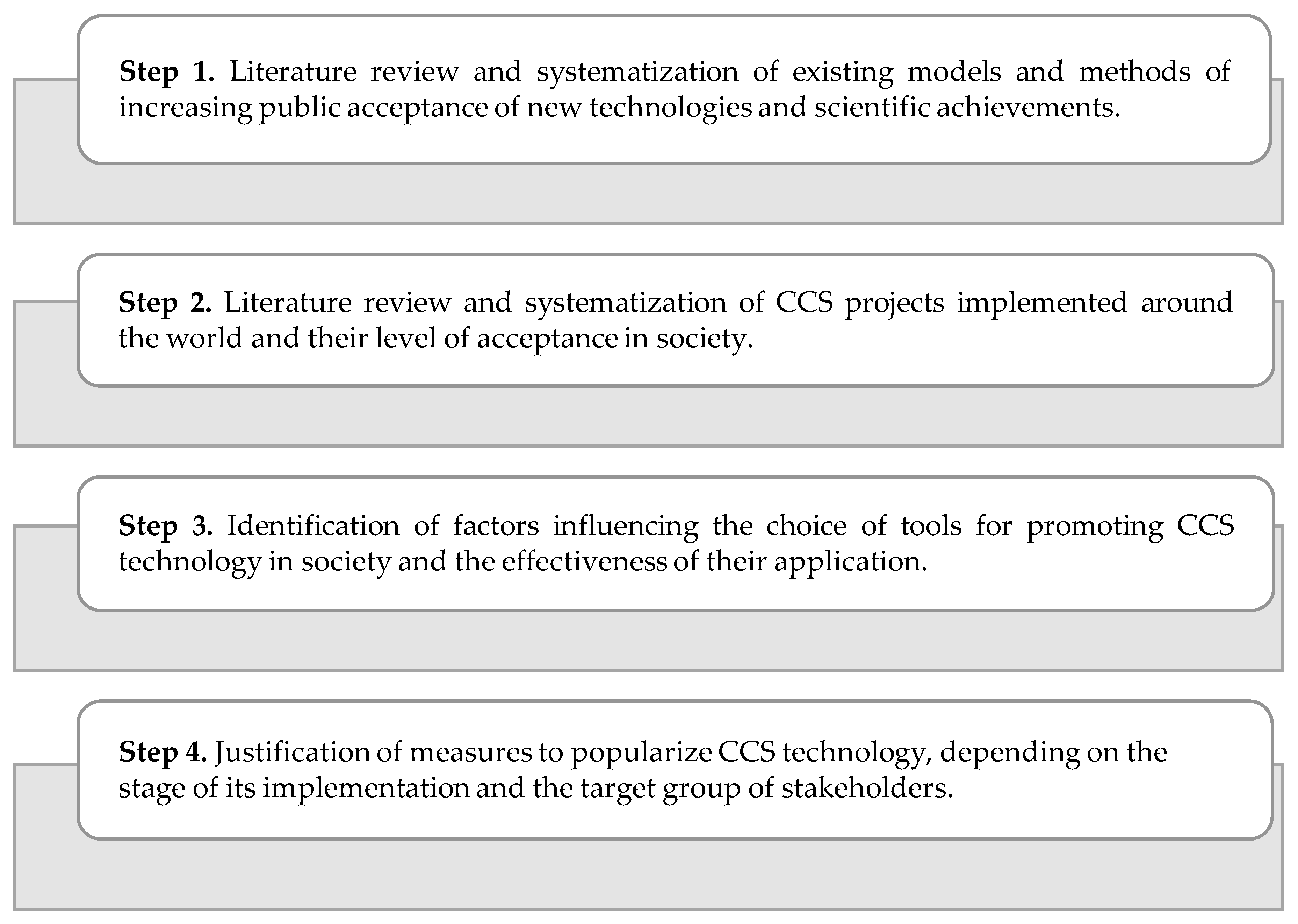
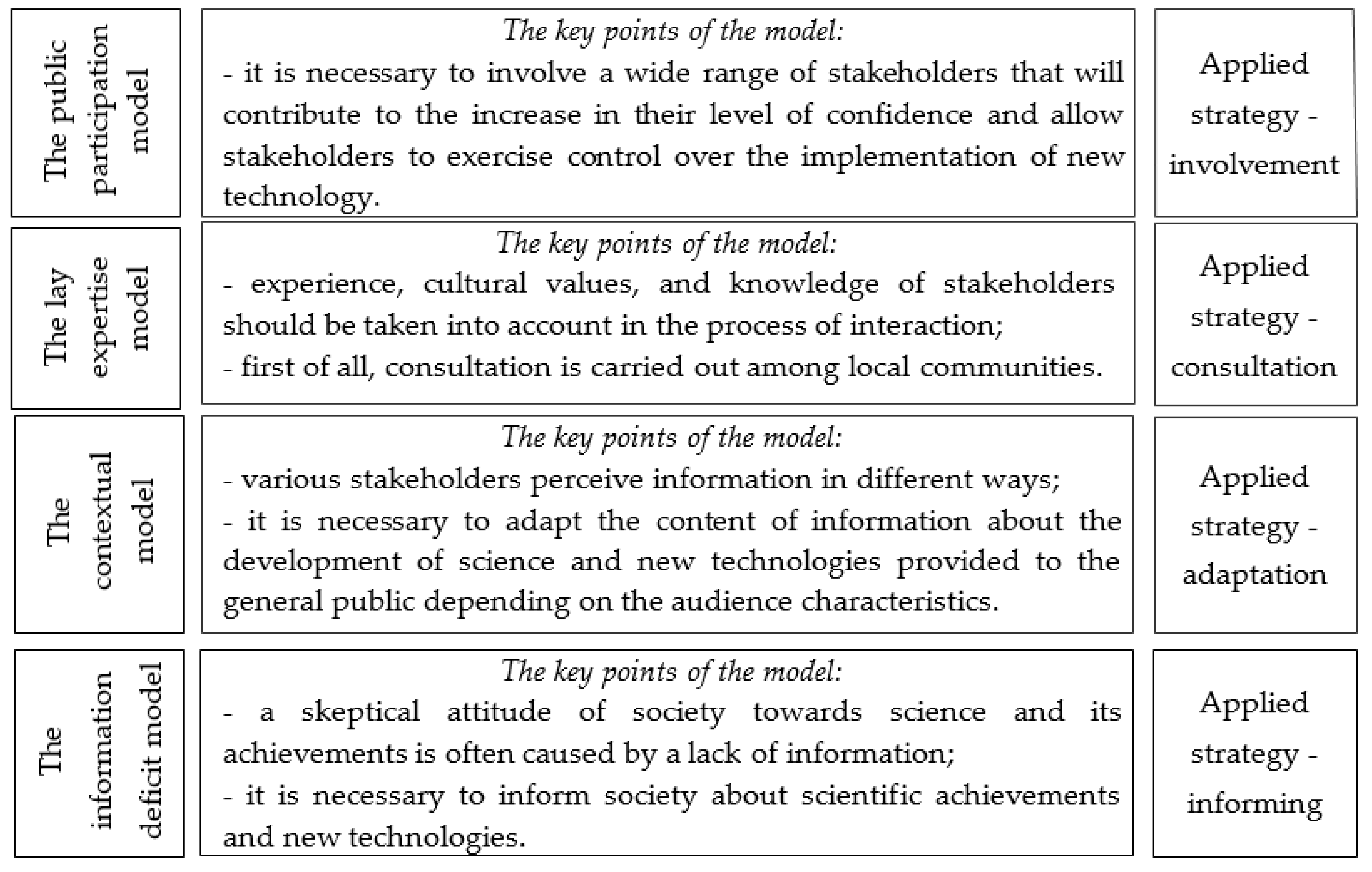
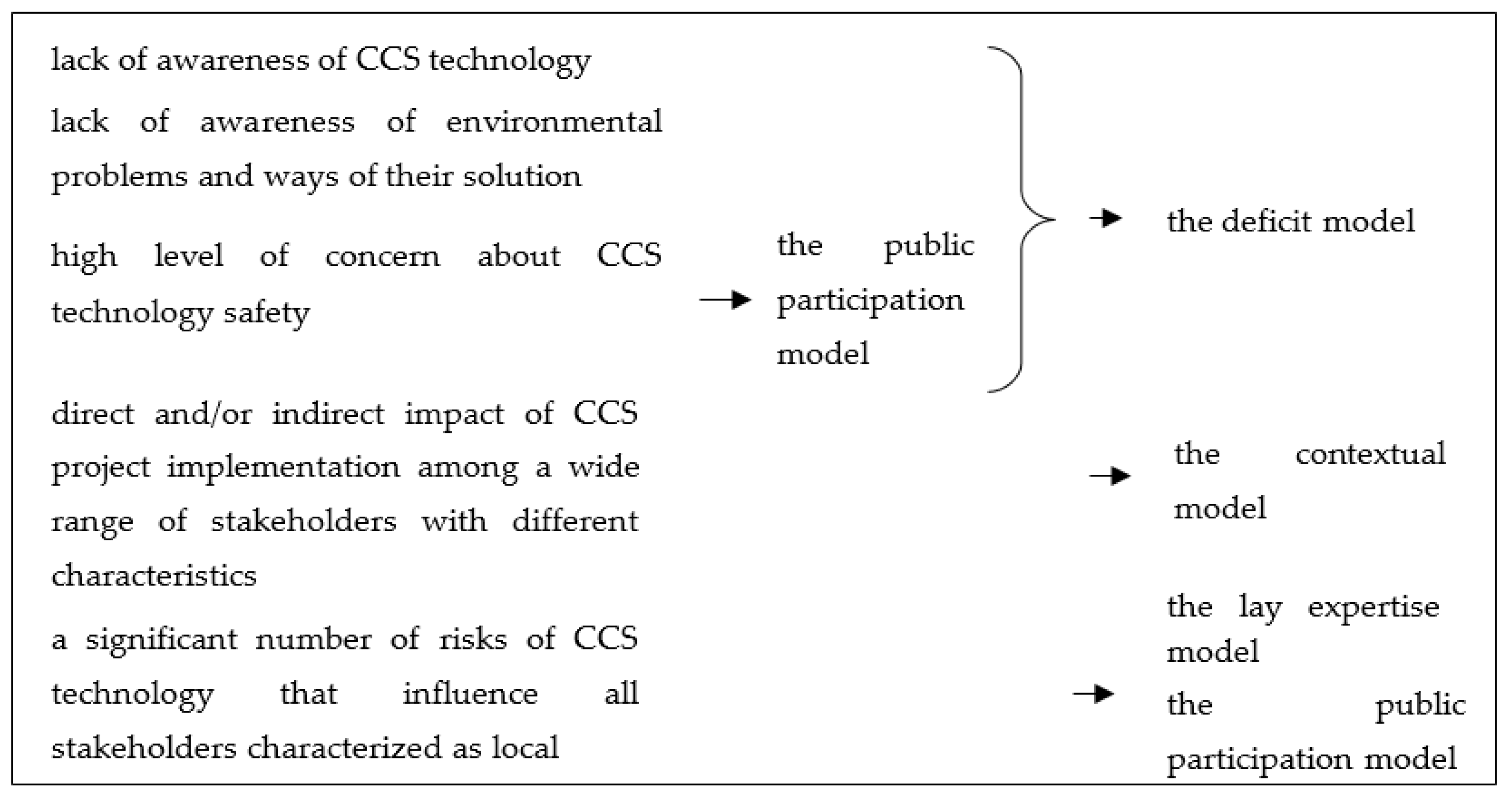
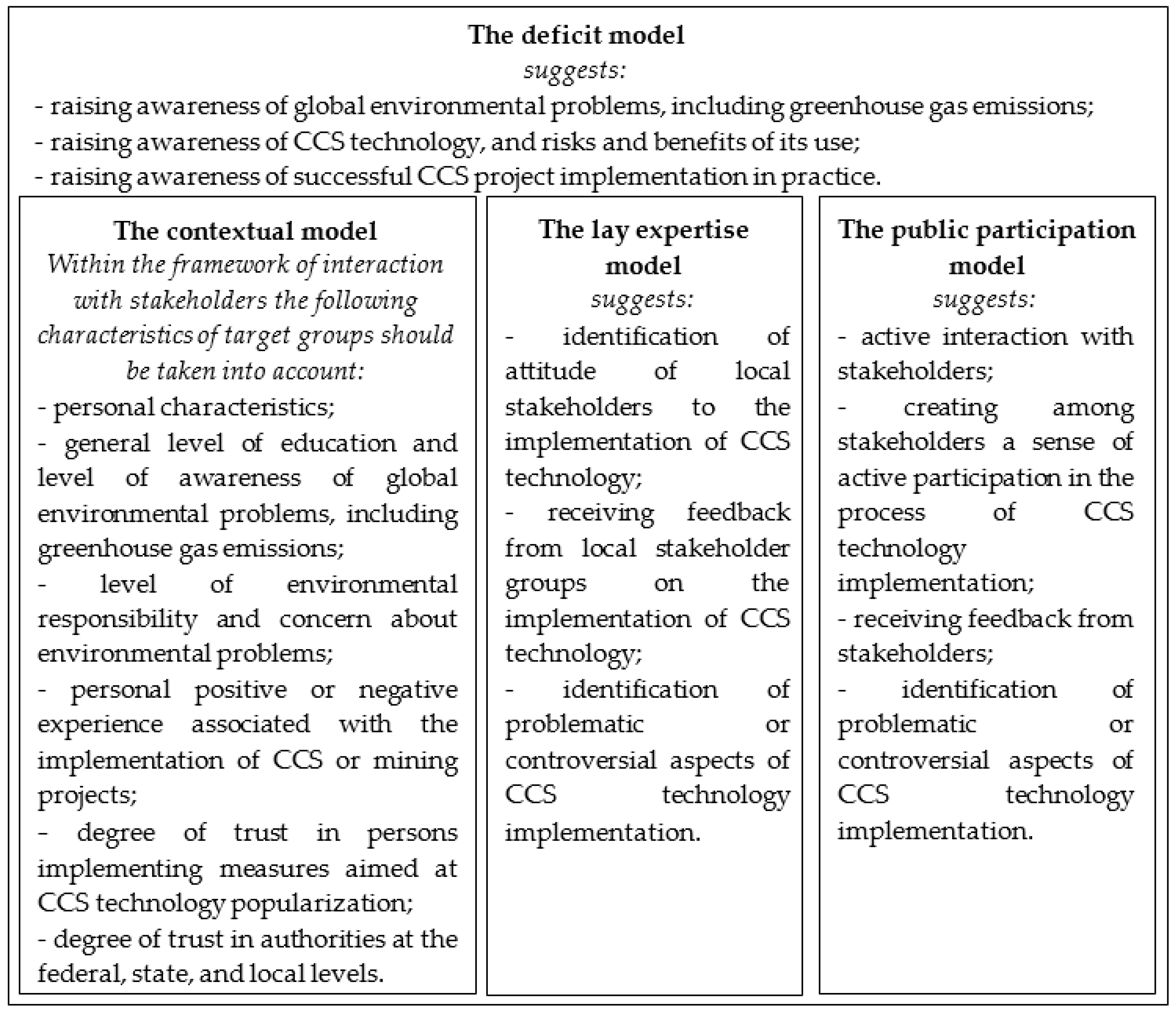
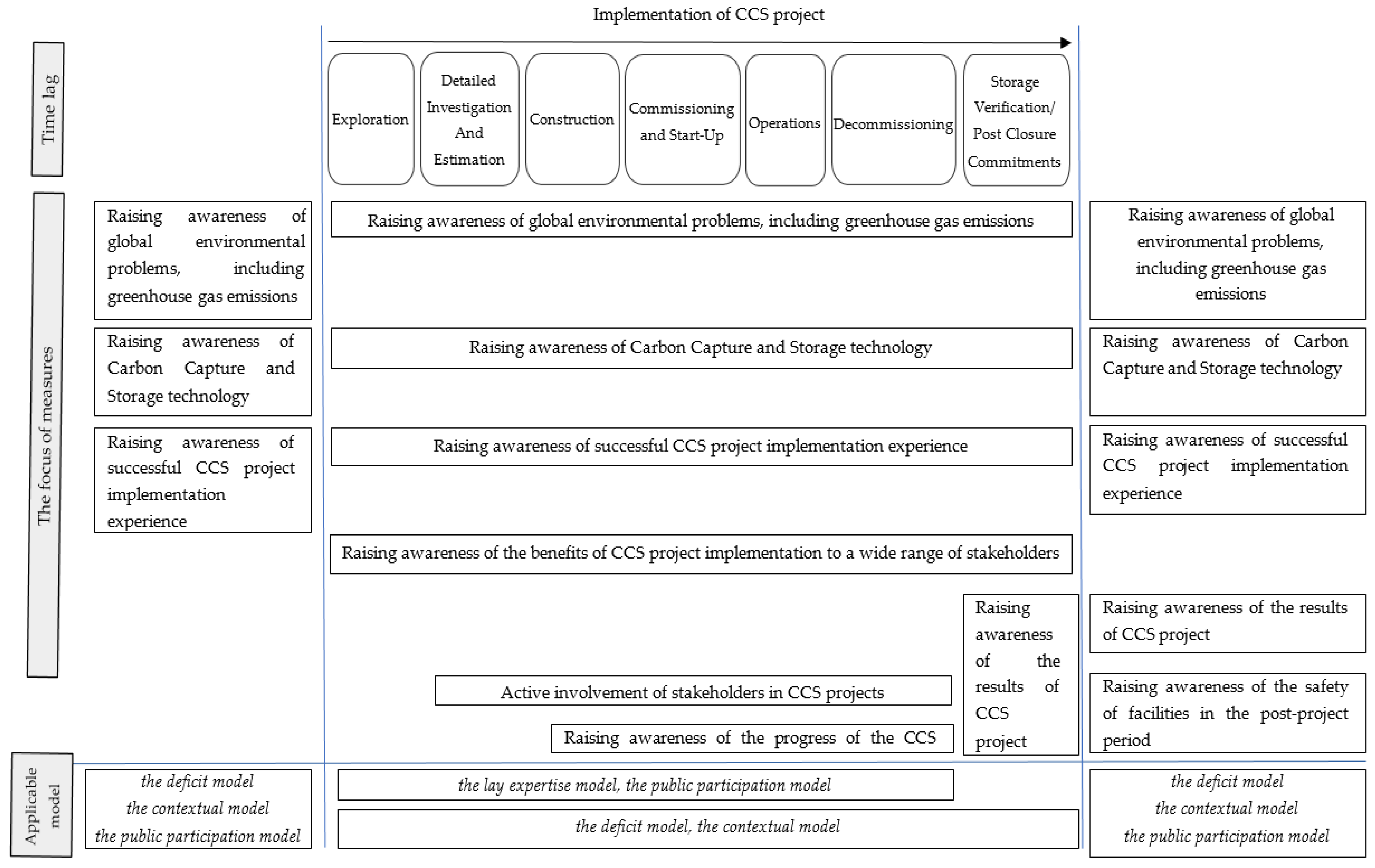
| Method | Objectives of the Method | Target Group | Advantages | Disadvantages |
|---|---|---|---|---|
| Educational | ||||
| Courses dedicated to the environmental challenges facing modern society, the development of technologies aimed at their solutions, implemented within the educational programs of secondary and higher education. | Informing | Students |
|
|
| Courses distributed by online platforms devoted to the environmental challenges facing modern society, the development of technologies aimed at their solution, and also to disclosure of the content, risks, and benefits of CCS technology. | Informing | General public with access to the Internet |
|
|
| Educational programs (professional development programs, retraining of personnel) dedicated to the environmental challenges facing modern society, the development of technologies aimed at their solution, and also to disclosure of the content, risks, and benefits of CCS technology. | Informing | Representatives of organizations operating in the field of environmental protection, oil production, etc. |
|
|
| Media | ||||
| Videos or popular science movies and TV shows devoted to environmental problems and environmental technologies, including CCS technology. | Informing | General public |
|
|
| Coverage of environmental problems and environmental technologies, including CCS technology, in the print media. | Informing | General public |
|
|
| Websites devoted to carbon capture and storage technology and specific CCS projects. | Informing/ involvement | General public with access to the Internet |
|
|
| Coverage of environmental issues and environmental technologies, including CCS technology, in social networks | Informing/ involvement | General public with access to the Internet |
|
|
| Distribution of printed materials (flyers, brochures, posters, etc.) | Informing | General public |
|
|
| Event | ||||
| Lectures and presentations on environmental issues and environmental technologies, including CCS technology | Informing | General public |
|
|
| Consensus conference | Informing/ involvement | General public, local communities |
|
|
| Exhibitions devoted to environmental problems and environmental technologies, including CCS technology | Informing | General public |
|
|
| Information Centers | Informing/ involvement | Local communities |
|
|
| Stakeholder meetings | Informing/ involvement | General public, local communities |
|
|
| Visit a project site | Informing/ involvement | Local communities |
|
|
| Database Name | Information Contained in the Database |
|---|---|
| The National Energy Technology Laboratory’s (NETL) Carbon Capture and Storage (CCS) Database | Project name, company, plant name, type of project, project overall status, plant status, project phase, country location, state location, specific site location, plant size or capture amount, combustion/separation, capture technology, amount of CO2 captured/stored, project summary, project start date, project cost, project information webpage. |
| CO2RE (a database of CCS facilities of the Global CCS Institute) | Project name, country location, type of project, project overall status, project short description, project start date. CO2 emissions data, policy, regulatory and storage emissions data. |
| The CCS project database provided by the Carbon Capture and Sequestration Technologies at MIT | Project name, company, location, type of capture technology, project overall status, project start date, project cost, economic indicators, project information webpage, project information and comments, including public attitude. |
Publisher’s Note: MDPI stays neutral with regard to jurisdictional claims in published maps and institutional affiliations. |
© 2020 by the authors. Licensee MDPI, Basel, Switzerland. This article is an open access article distributed under the terms and conditions of the Creative Commons Attribution (CC BY) license (http://creativecommons.org/licenses/by/4.0/).
Share and Cite
Cherepovitsyn, A.; Chvileva, T.; Fedoseev, S. Popularization of Carbon Capture and Storage Technology in Society: Principles and Methods. Int. J. Environ. Res. Public Health 2020, 17, 8368. https://doi.org/10.3390/ijerph17228368
Cherepovitsyn A, Chvileva T, Fedoseev S. Popularization of Carbon Capture and Storage Technology in Society: Principles and Methods. International Journal of Environmental Research and Public Health. 2020; 17(22):8368. https://doi.org/10.3390/ijerph17228368
Chicago/Turabian StyleCherepovitsyn, Alexey, Tatiana Chvileva, and Sergey Fedoseev. 2020. "Popularization of Carbon Capture and Storage Technology in Society: Principles and Methods" International Journal of Environmental Research and Public Health 17, no. 22: 8368. https://doi.org/10.3390/ijerph17228368
APA StyleCherepovitsyn, A., Chvileva, T., & Fedoseev, S. (2020). Popularization of Carbon Capture and Storage Technology in Society: Principles and Methods. International Journal of Environmental Research and Public Health, 17(22), 8368. https://doi.org/10.3390/ijerph17228368






